Table of contents
1. The Rollercoaster Patient Journey of Managing Period Pain
2. Breaking the cycle: understanding what causes period pain
3. The Real Cost of Period Pain in the UK
4. Meet our Period & Pelvic Pain clinic
5. Conclusion
Written by Kalina Mihaylova
Medically reviewed by Sarah Montagu (RN DFSRH, BSc)
Illustrated by Maria Papazova
How many times have you spent a morning curled up on your bathroom floor in agony as cramps steadily squeezed and released your uterus? Pressing a hot water bottle to your lower abdomen and willing your uterine muscles to relax, while simultaneously screwing your eyes shut as another wave of excruciating pain rips through you?
And then: How many times have you told someone about it afterwards, only to be met with the response: ‘Well, it’s part and parcel of having a uterus, isn’t it?’.
We’ve all heard it. We may have even (although we’re not proud of it) all said it, at some point in our lives.
But nobody should have to struggle with agonising period pain because society normalises this sort of pain for people with wombs. In fact, this sort of pain shouldn’t be normalised, period (pun intended). And that’s before we’ve even started talking about the immensely frustrating journey we often have to embark upon if we want any concrete answers for why we’re experiencing said period pain (more on this below).
To put it bluntly: Here at Daye, we’ve had enough. And that’s why we’re so proud to present our innovative Period & Pelvic Pain Clinic: A digital platform designed to address the complex, painful, frustrating issues of menstrual and pelvic pain.
The aim? To provide personalised, evidence-based solutions for people experiencing any discomfort related to their menstrual cycle.
The Rollercoaster Patient Journey of Managing Period Pain
Managing chronic period pain can feel like navigating a labyrinth of appointments, tests, and treatments. It’s often a long, costly, and frustrating process that many go through alone and in silence. Here’s what a typical journey looks like for most:
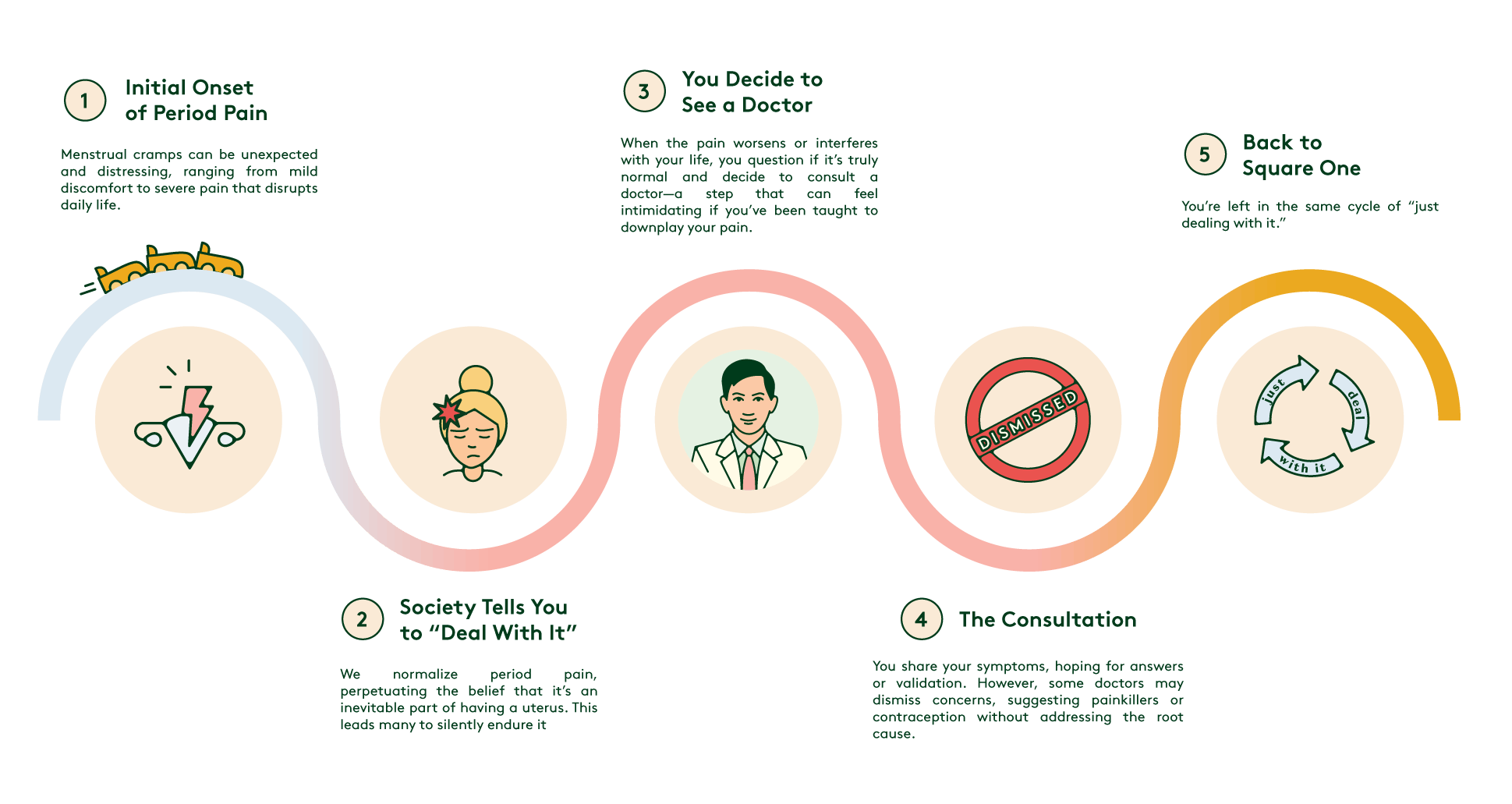
If you want relief from period pain, understanding that pain is the first step; quickly followed by understanding the existing barriers to care that, regrettably, are in place.
And that’s why we’re here. In this article, we’ll dive into what actually causes period pain. We’ll take a tour of the sheer cost of period pain in the UK; and we’ll then offer a perspective on a new and better patient journey. You’ve guessed it: it’s Our Period & Pelvic Pain Clinic, where you get access to accurate and personalised information about your body from Day One; saving years of suffering, frustration and money for those of us born with a cramping uterus.
Breaking the cycle: understanding what causes period pain
The knowledge we have of menstrual pain, or dysmenorrhea, has evolved significantly over the years. It wasn't until the 1970s that researchers identified prostaglandins (a word that probably strikes fear into the hearts of anyone who’s previously researched menstrual cramps) as a primary cause. Pioneering studies finally revealed that patients with dysmenorrhea produce significantly higher levels of these compounds, which trigger stronger uterine contractions and reduced blood flow.
Let’s break that down. As progesterone (<a hormone) levels drop at the end of the menstrual cycle, prostaglandins are released in the uterus. This leads to increased contractions and constricted blood vessels; which, in turn, means the tissues in the uterus get less oxygen. (No surprise it’s excruciating!) The pain experienced is directly related to the amount of prostaglandins produced – explaining why symptoms can vary so much among individuals. In other words, some people produce more prostaglandins than others; and subsequently experience more pain.
Prior to these discoveries, myths and misconceptions about menstrual pain's causes were everywhere. Some even attributed it to mechanical obstruction. But the identification of prostaglandins has, at long last, paved the way for more effective treatments – which can relieve pain by inhibiting prostaglandin production.
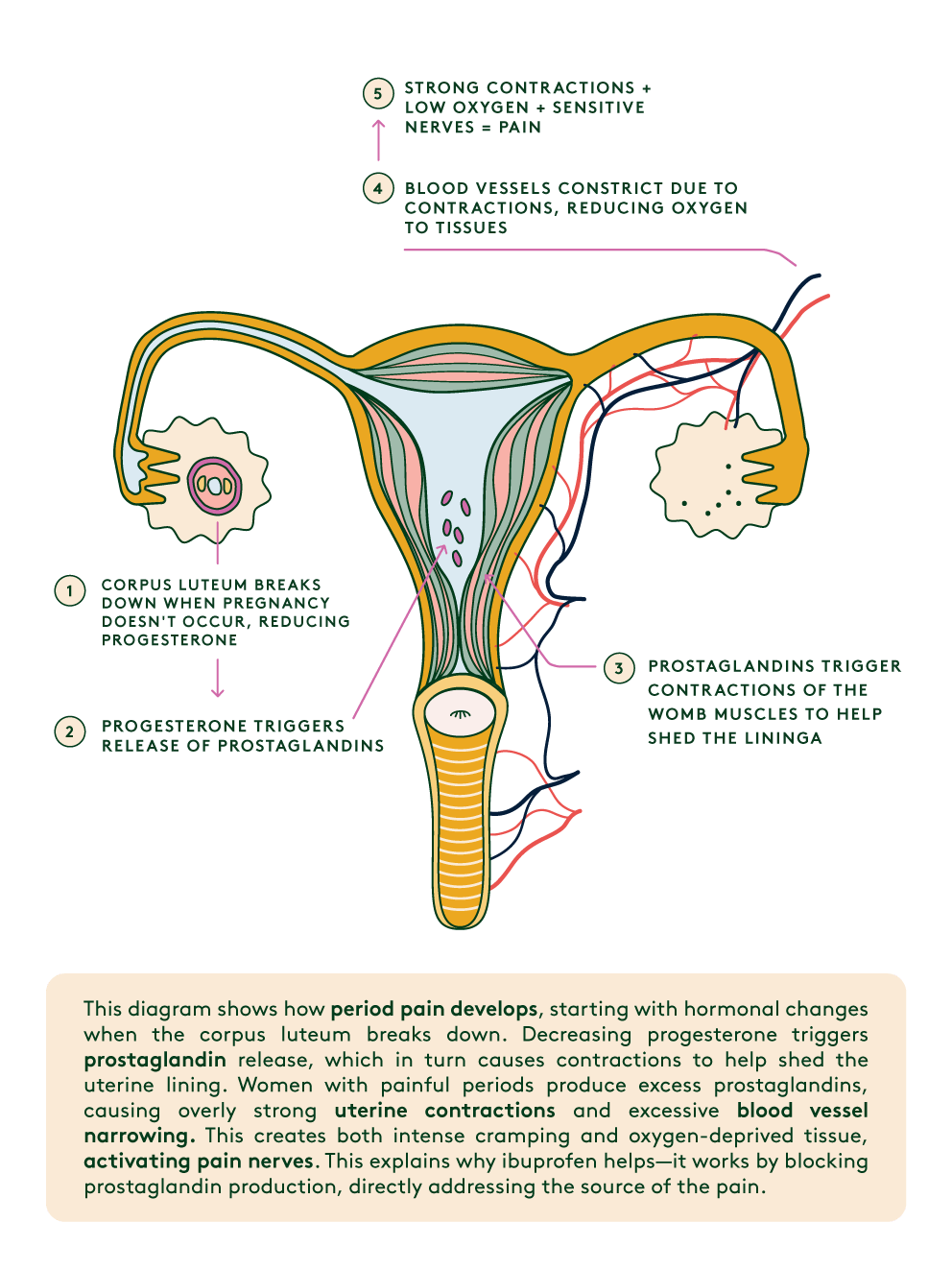
The Real Cost of Period Pain in the UK
As we know, period pain is very common – and yet the associated costs can be jaw-dropping. Both period pain and the wider gender pain gap (of which period pain is a symptom) have significant economic implications: Not just for us as individuals, but for our societies and healthcare systems as a whole.
Let’s take a look at some recent studies which have revealed staggering costs associated with menstrual health issues.
Severe period pain alone is estimated to cost the UK economy £3.7 billion annually in absenteeism. When combined with heavy periods, this figure rises to £8.4 billion per year.
£8.4 billion. No words? Us, too.
The gender pain gap, of course, extends beyond menstruation, with poorly managed gynaecological health issues costing the UK economy a total of £20.2 billion annually due to lost productivity. Yep – our jaws are dropping, too.
This economic burden is compounded by the fact that women and AFAB individuals spend approximately £100 more per year on out-of-pocket healthcare expenses compared to cis-men.
In case you want a cost breakdown, here you go:
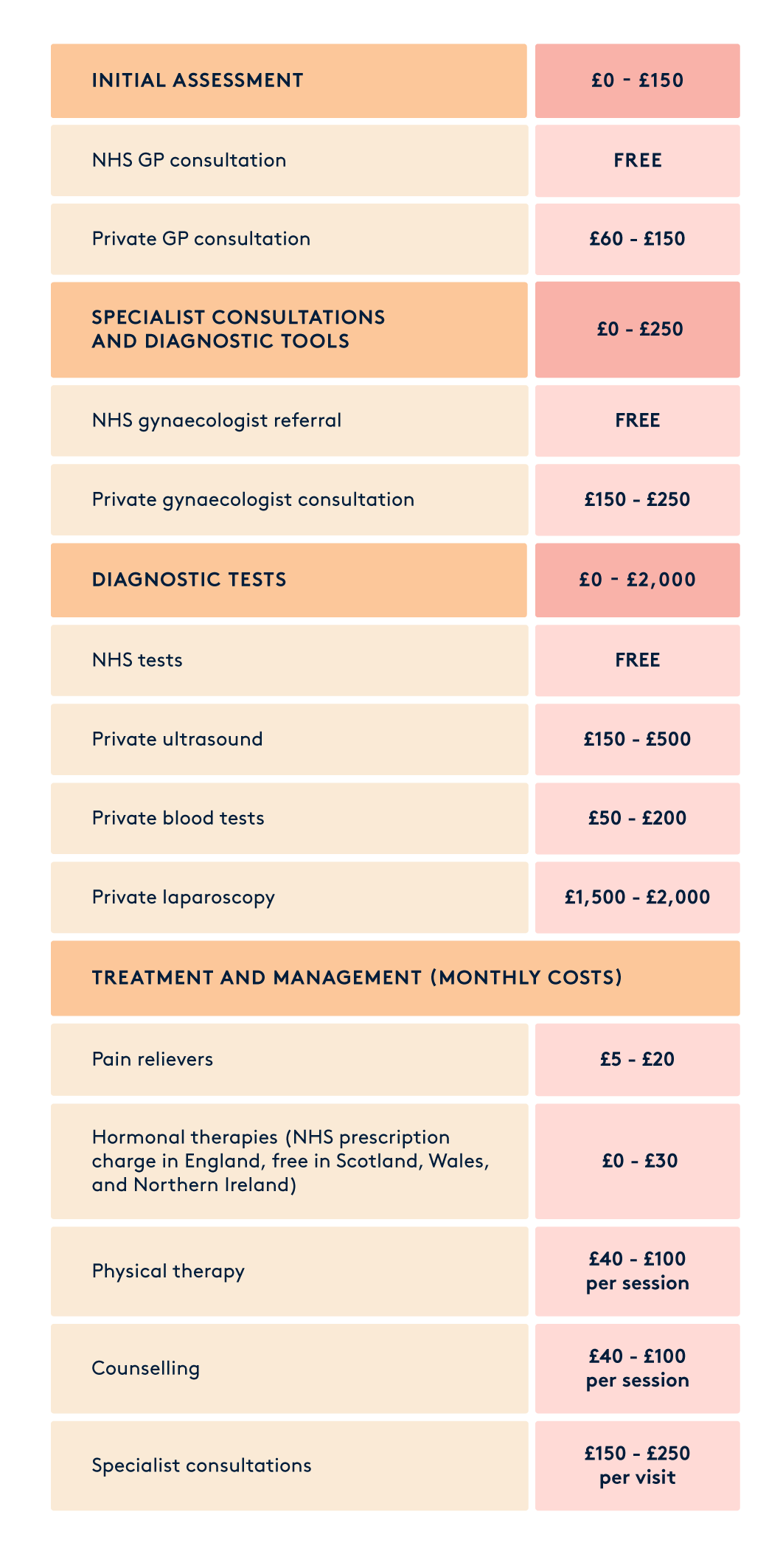
Some of those costs are horrifying – but it’s important to note that many of these services are available for free, or at reduced costs, through the NHS; which, hopefully, significantly lowers the financial burden for UK residents.
But we mean it when we say the ongoing situation with gynaecological healthcare in the UK is seriously concerning.
As of January 2025, approximately 700,000 women are on gynaecological health waiting lists, facing significant delays in receiving essential care. These extended waiting times – often stretching for months or even years – are forcing many of us to choose between enduring prolonged discomfort, and seeking private care at considerable personal expense.
Like we said: Here at Daye, we’ve had enough. We believe in providing the best-in-class gynaecological care with access and affordability in mind; which brings us onto our Period & Pelvic Pain Clinic.
Meet our Period & Pelvic Pain clinic
Daye has launched the Period & Pelvic Pain Clinic to address the aforementioned critical gap in women's healthcare. Despite menstrual pain affecting up to 90% of women and AFAB individuals, there has been – as we now know – a historical lack of research, understanding, and effective treatment options for this condition.
So we’ll say it one more time (last time, we promise): We’ve had enough.
This clinic aims to revolutionise the approach to period pain management by offering solutions that go beyond the traditional "grin and bear it" mentality.
By providing a path to fast-tracked diagnosis, tailored treatment plans, and access to vetted specialists, we aim to reduce the average 7-year wait time for diagnoses of conditions like endometriosis, adenomyosis and PCOS: All of which can include painful periods among their symptoms.

Streamlined Diagnosis
The Period & Pelvic Pain Clinic has a comprehensive, technology-driven approach to diagnosis:
In-depth Questionnaire: Our process begins with a detailed, clinical questionnaire that captures your unique symptom profile and medical history. It’s designed to uncover subtle patterns and connections that might be missed in a typical doctor's visit.
Advanced Clinical Algorithm: This is based on the latest guidelines from leading medical bodies such as the RCOG, ACOG, NICE, and ESHRE. This algorithm analyses your responses to identify potential underlying conditions, including endometriosis, PCOS, adenomyosis, fibroids, and primary dysmenorrhea.
Rapid Risk Assessment: Within minutes of completing the questionnaire, you receive a preliminary risk assessment for various pelvic pain conditions, helping you prioritise next steps in your diagnostic journey.
Targeted Testing Recommendations: Based on your risk profile, we provide recommendations for specific tests or imaging studies that are most likely to actually give you meaningful results; thus reducing unnecessary procedures and accelerating the path to diagnosis.
Holistic Health Mapping: Our system doesn't just focus on gynaecological issues. It also considers how factors like stress, sleep, diet, and exercise may be impacting your pain, giving you a more complete picture of your health.
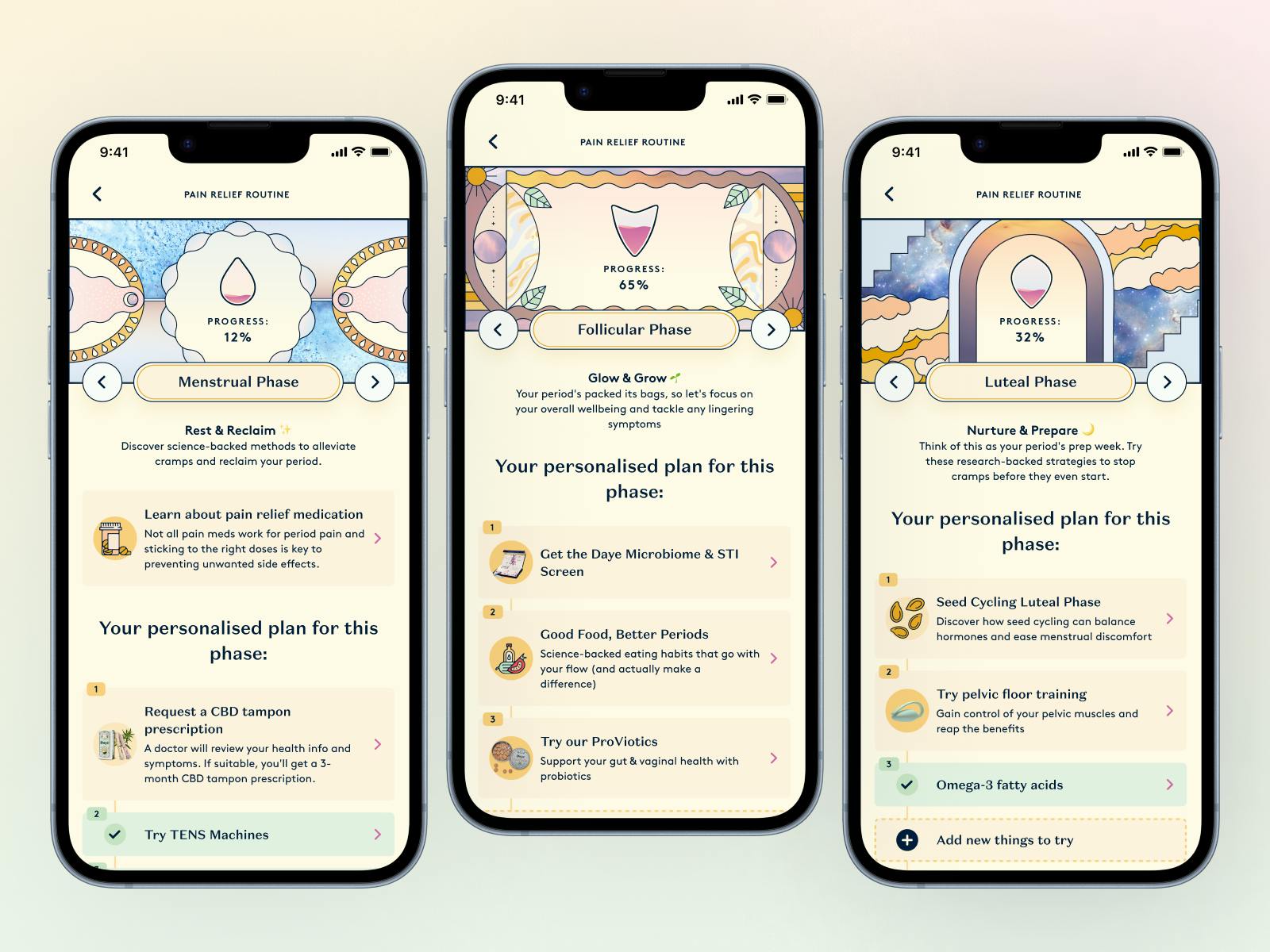
Personalized Treatment Plans
At Daye, we believe in empowering you with a diverse toolkit to manage your period and pelvic pain effectively:
Tailored Pharmaceutical Options: Our treatment plans may include carefully selected pain relief medications, hormonal therapies, or other prescription drugs specifically chosen to address your symptoms and underlying conditions.
Evidence-Based Natural Remedies: We integrate scientifically supported natural remedies (like specific supplements and/or acupuncture), into your plan when appropriate.
Innovative Pain Management: Your plan might include cutting-edge options like CBD tampons or TENS devices, which have shown promise in managing menstrual and pelvic pain.
Lifestyle Interventions: We provide detailed recommendations on diet, exercise, stress management, and sleep hygiene tailored to your specific needs and pain patterns.
Pelvic Floor Therapy: When indicated as possibly being helpful for you, we incorporate pelvic floor exercises and techniques, providing detailed instructions and follow-up.
Tracking and Adjustment: Through our digital platform, you can easily track your symptoms and treatment efficacy, which means there’s the option to continuously refine your treatment plan.
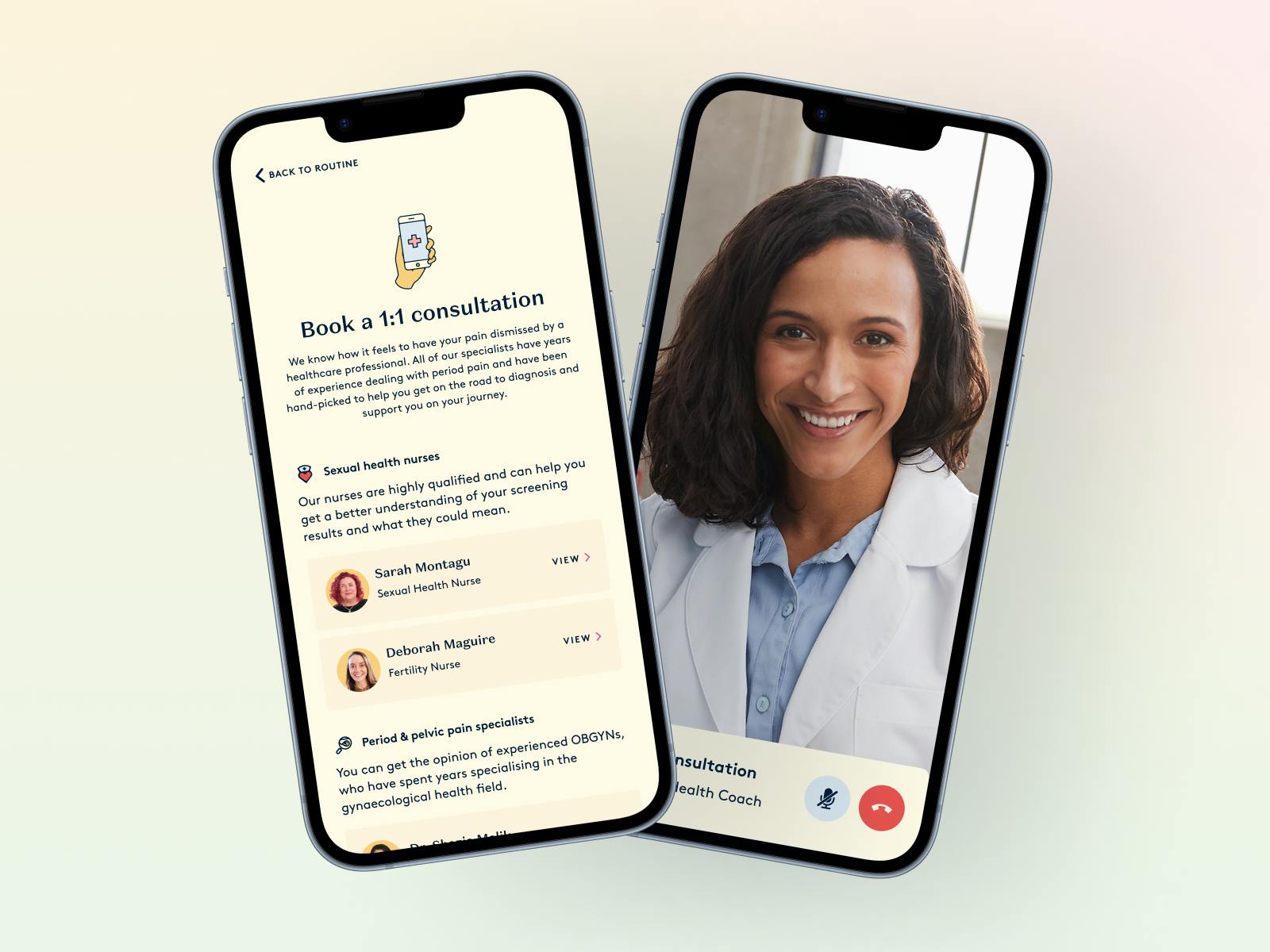
Expert Support
And we can’t let you go without shining a light on how accessible our consultations are, which is yet another way in which this Period & Pelvic Pain Clinic breaks down barriers to specialized care:
Vetted Specialist Network: We've assembled a network of gynaecologists, pain management specialists and pelvic health experts who are not only highly qualified, but also trained in empathetic, patient-centred care.
Seamless Booking: Our user-friendly interface lets you book appointments at times that suit your schedule, including evening and weekend slots.
Continuity of Care: The portal keeps a comprehensive record of your consultations, treatments, and progress, so that all healthcare providers have the full picture of your health journey.
In-Person Care Coordination: When physical examinations or procedures are necessary, we facilitate smooth transitions to in-person care, coordinating with local providers while maintaining oversight of your overall treatment plan.
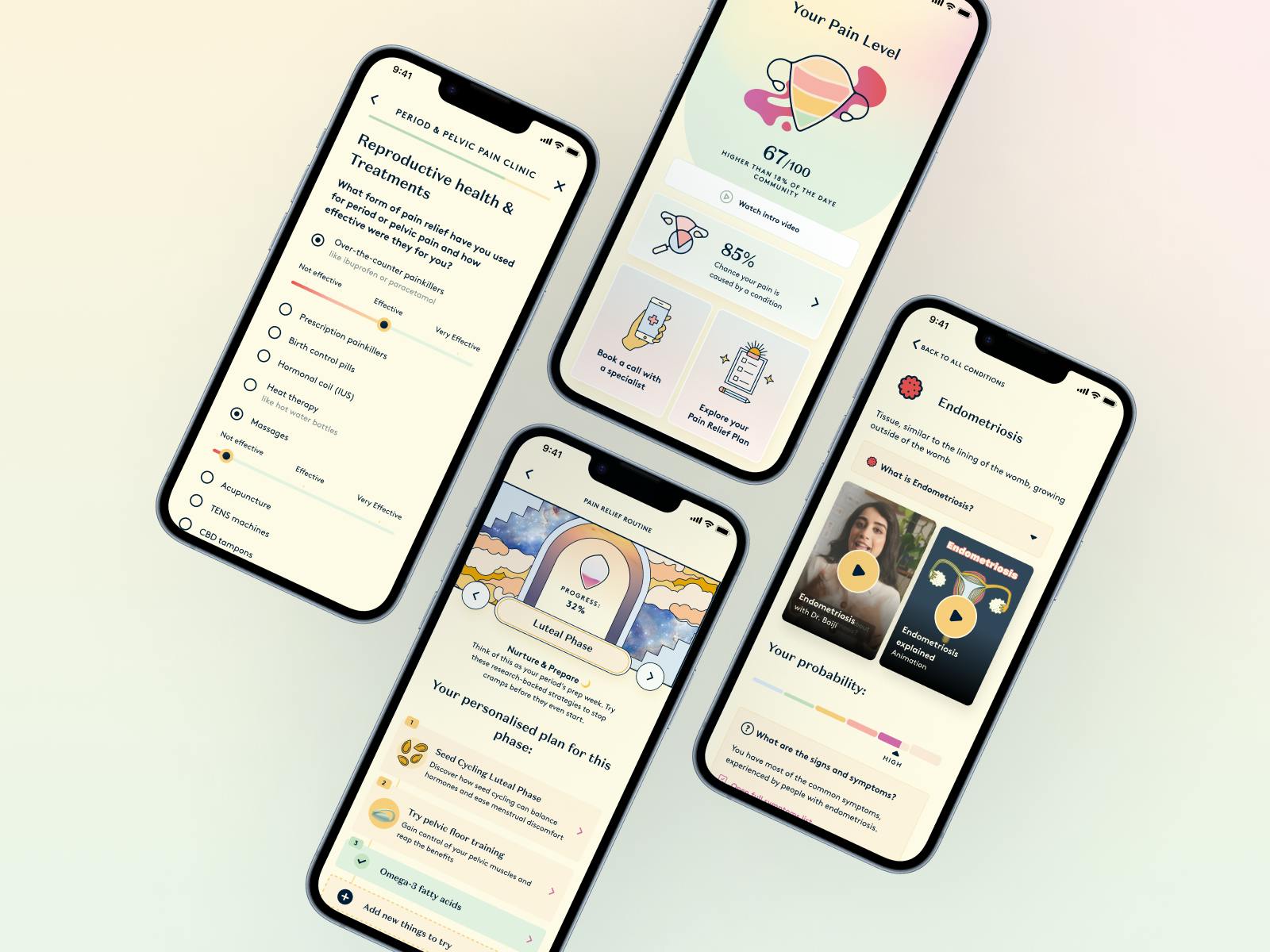
By combining advanced technology with personalised care, our Period & Pelvic Pain Clinic aims to dramatically reduce the waiting time for not only diagnosis, but effective treatment, too – empowering you to take control of your menstrual and pelvic health.
Conclusion
Managing chronic period pain can be nothing short of hell, for all the reasons we’ve discussed. It can be lonely; it can be expensive; it can be excessively long; and it can be, at the risk of stating the obvious, incredibly painful. Not to mention the limited (or lack of) access to healthcare, and societal stigma that are often at play for many people, and which can further complicate this process.
But Daye’s Digital Period Pain Clinic offers a modern, efficient alternative. By streamlining diagnosis, providing accessible consultations, and offering personalised treatment plans, Daye significantly reduces the time and effort required to manage period pain effectively.
We’re transforming the patient journey, making it easier for you to get that pain relief you desperately need, and to subsequently improve your quality of life.
Join Daye and take control of your period pain journey today!
Take the pain out of your period
90% of us experience period pain, and when left unmanaged it leads to us losing 150 million productive work days per year.





